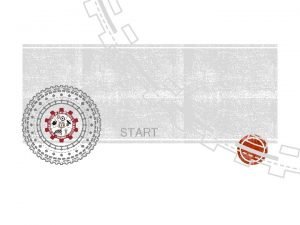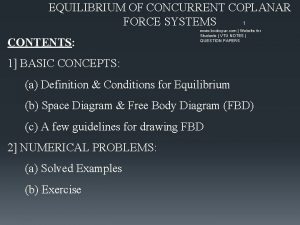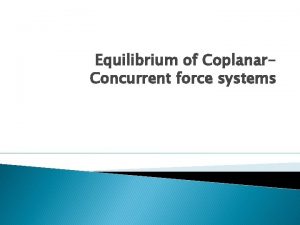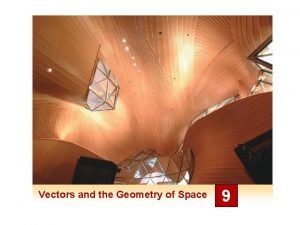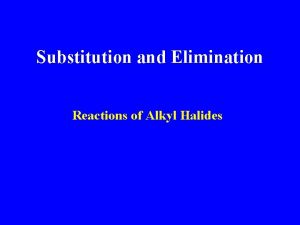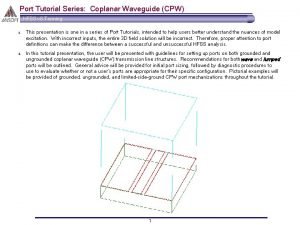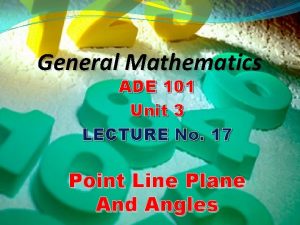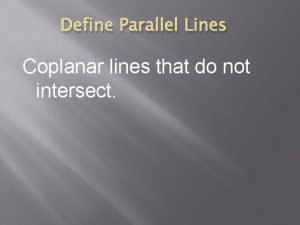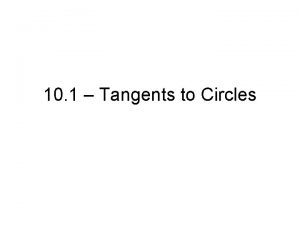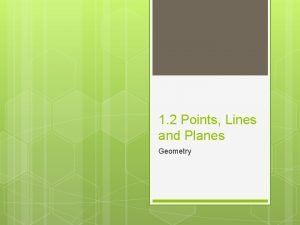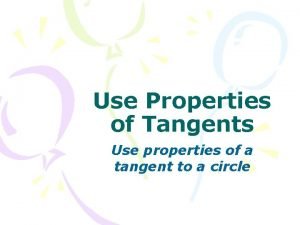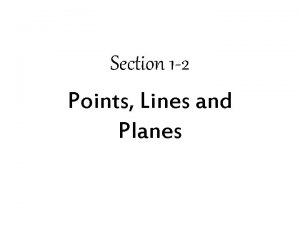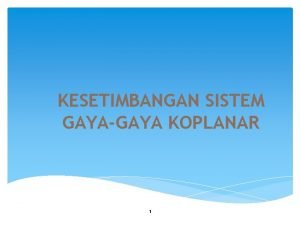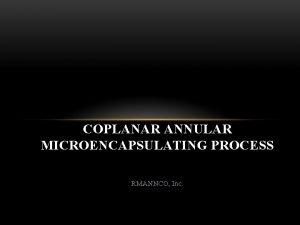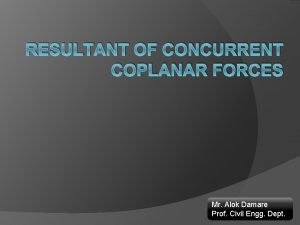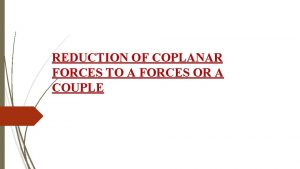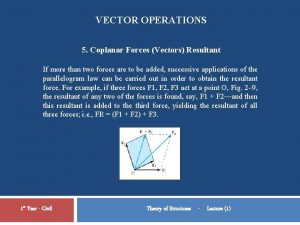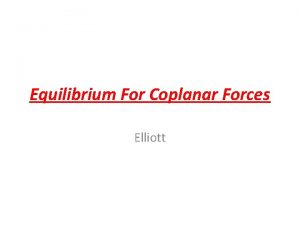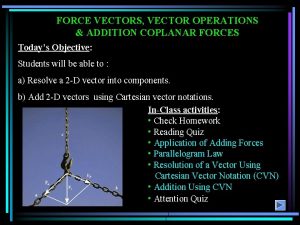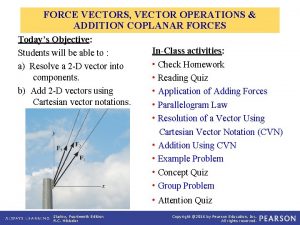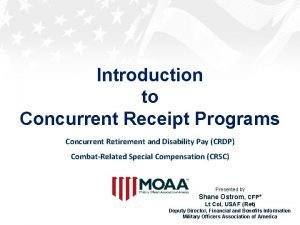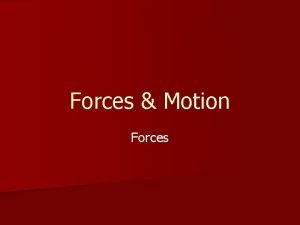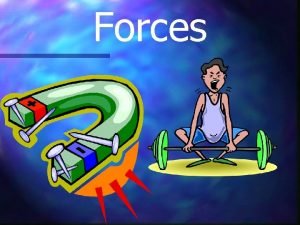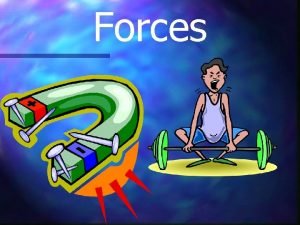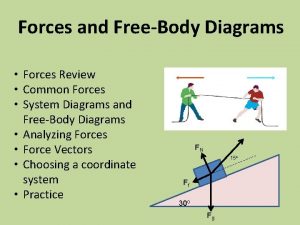Chapter 2 Coplanar Concurrent Forces Introduction In the
























- Slides: 24

Chapter 2 Coplanar Concurrent Forces

Introduction �In the first chapter we discussed about simple case of concurrent forces, where only two non parallel forces were considered. �However, in many cases, the lines of action of three or more forces may intersect at a single point, and can form a system of concurrent forces. �In this chapter we are going to discuss these type of coplanar concurrent forces.

Resultant of Concurrent Force (Algebraically) � Find ∑ Fx, ∑ Fy then determine the resultant force and the angle. (The sense in which each force acts is considered) � Ax = A cos α, Bx = B cos β, Cx = C cos γ � Ay = A sin α, By = B sin β, Cy = C sin γ � ∑ Fx = A cos α - B cos β - C cos γ � ∑ Fy = A sin α - B sin β - C sin γ � Resultant force, R = [(∑ Fx)2 + (∑ Fy)2]1/2 � Direction or angle, tanθ′ = ∑ Fy / ∑ Fx

Example- 16 �Find algebraically the resultant of the force system shown in Fig 20 (a)

Equilibrium �A system of forces where the resultant is zero is said to be in Equilibrium. (Defined by Newton’s First Law) �Now If, R= 0 then, �∑ Fx = 0 �∑ Fy = 0 �The above two equations can be used to find two unknowns.

Equilibrium

Problem 57 �R is the resultant of F, T and Q, shown in Fig. 33. F = 150 lb. , θ = 30º, R = 85 lb. Find Q and α. �Example 21 - Do it yourself

Free Body �Most bodies in equilibrium are at rest. �But a rigid body moving with constant speed in a straight path is also in equilibrium. �A rigid body may be any particular mass whose shape remains unchanged while it is being analyzed for the effect of forces. �Since no body is truly rigid, we mean by ‘rigid body’ is one whose deformation under force is negligible for the purposes of the problem. �A free body is a representation of an object, usually a rigid body , which shows all the forces acting on it. (See page 2223 of Analytic Mechanics by Virgil Moring Faires for details)


Example


Problem 72 �A 5000 lb sphere rests on a smooth plane inclined at an angle θ = 45 º with the horizontal and against a smooth vertical wall. What are reactions at the contact surface A and B, Fig. 39?

Equilibrium of Three Forces & Force Polygon

Equilibrium of Three Forces & Force Polygon Again from the equation of equilibrium, �∑Fx = F 2 cos 45º - F 1 cos 60º = 0 �∑Fy = F 2 sin 45º + F 1 sin 60º = 0

Problem: 91 �Two weights are suspended from a flexible cable as shown in Fig. 46. For θ = 120º, determine the internal forces in various parts of the cable and weight W.

Trusses ? �Trusses are mainly used to support Roofs and Bridges.

Trusses: Joint to joint method �A determinate structure is one wherein the internal forces in the various members of the structure may be obtained by the conditions of equilibrium. �Although truss is subjected to all manner of loading, for simplicity it is assumed that, the loads on truss are applied at pin joints �So, with a truss loaded in this manner, all the various members are two force members and the free body of each pin is a system of concurrent forces. �If all the external forces including the reactions at the supports are known, then the above principles can be used to determine the internal forces in each member. �To determine the member forces, it is assumed that the unknown forces are acting away from the pin, which means that the members are in tension. �Solve for each of the unknowns by using the conditions of equilibrium, i. e. , ∑ Fx = 0, ∑ Fy = 0.

Example 22 �A roof truss is constructed and loaded as shown in Fig. 27. At the pin N, the following internal forces have been found: NF = 16900 lb (tension), DN = 7000 lb (compression) and NH = 12565 lb (tension). For an external load at the pin of 6000, find the forces in the members NC and NB.

Closure �See Book Page: 32 from Analytic Mechanics by Virgil Moring Faires

Assignments From Book (Analytic Mechanics by Virgil Moring Faires): �Problem: 77 �Problem: 79 �Problem: 114 �Problem: 137 �Problem: 138

Assignments

Assignments


 Non concurrent forces examples
Non concurrent forces examples What is coplanar forces
What is coplanar forces Equilibrium of coplanar force system
Equilibrium of coplanar force system Concurrent force system example in human body
Concurrent force system example in human body Like parallel forces diagram
Like parallel forces diagram The forces shown above are
The forces shown above are Intramolecular vs intermolecular bonds
Intramolecular vs intermolecular bonds Inter vs intramolecular
Inter vs intramolecular Intramolecular forces vs intermolecular forces
Intramolecular forces vs intermolecular forces Contact and noncontact forces
Contact and noncontact forces Balanced forces and unbalanced forces venn diagram
Balanced forces and unbalanced forces venn diagram Constructive forces and destructive forces
Constructive forces and destructive forces Coplanar formula
Coplanar formula Anti-coplanar
Anti-coplanar Tutorial
Tutorial Non coplanar points
Non coplanar points Coplanar lines definition
Coplanar lines definition Line that is tangent to two coplanar circles
Line that is tangent to two coplanar circles What is collinear and coplanar
What is collinear and coplanar Circle and tangent properties
Circle and tangent properties Collinear points
Collinear points Parallel lines
Parallel lines Worksheet 1-1 points, lines, and planes day 1
Worksheet 1-1 points, lines, and planes day 1 Site:slidetodoc.com
Site:slidetodoc.com Gambar gaya koplanar
Gambar gaya koplanar
